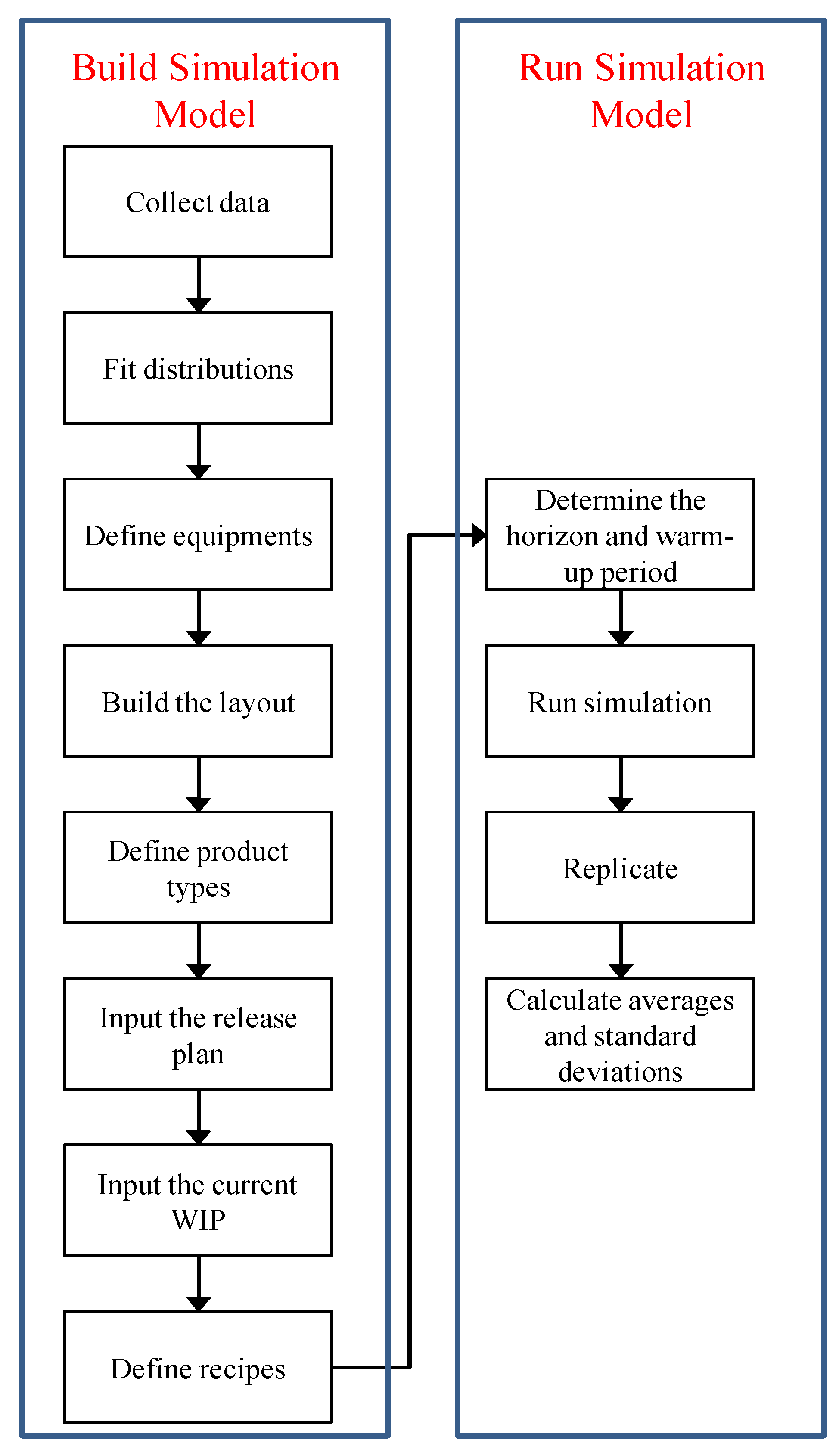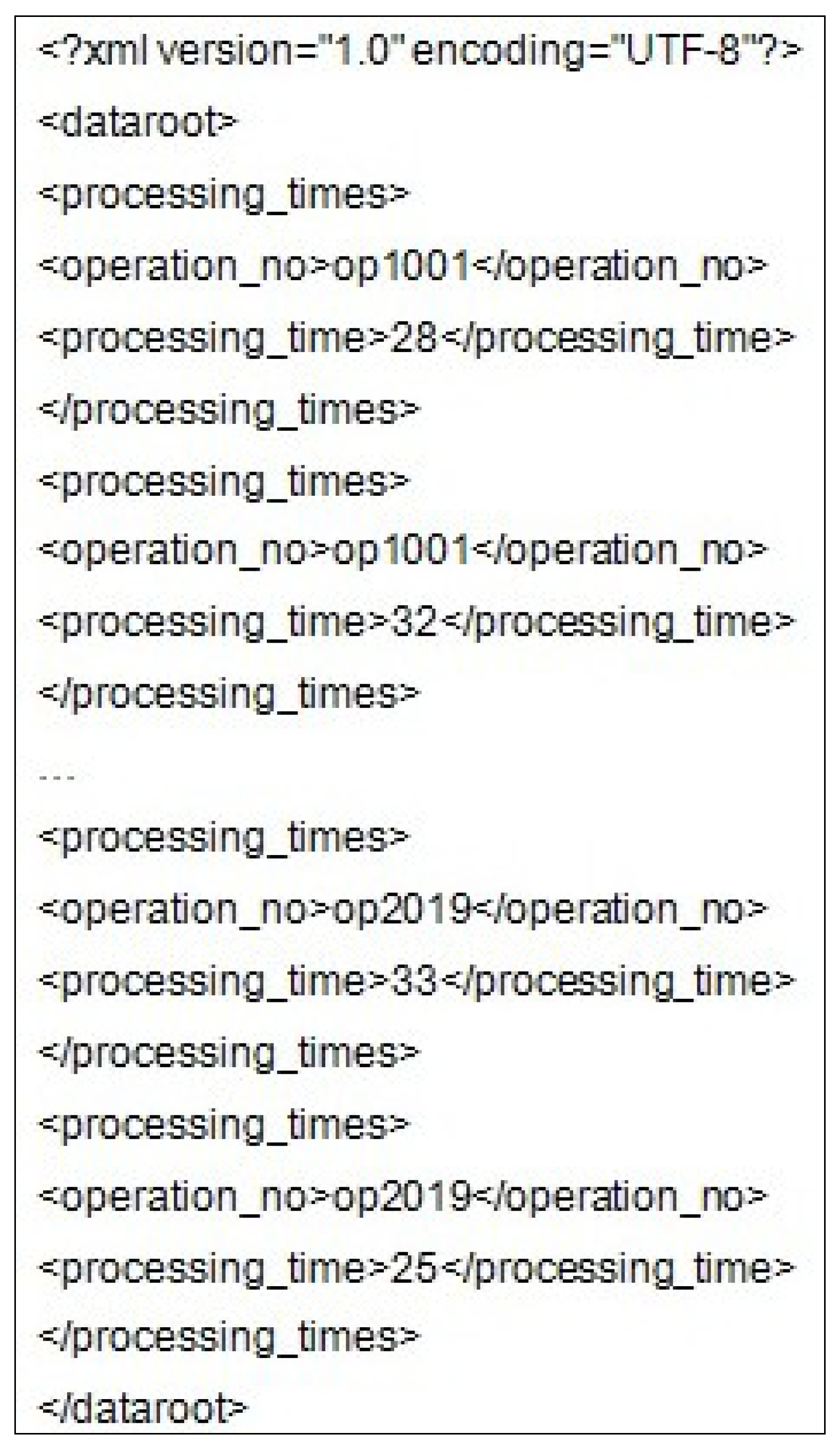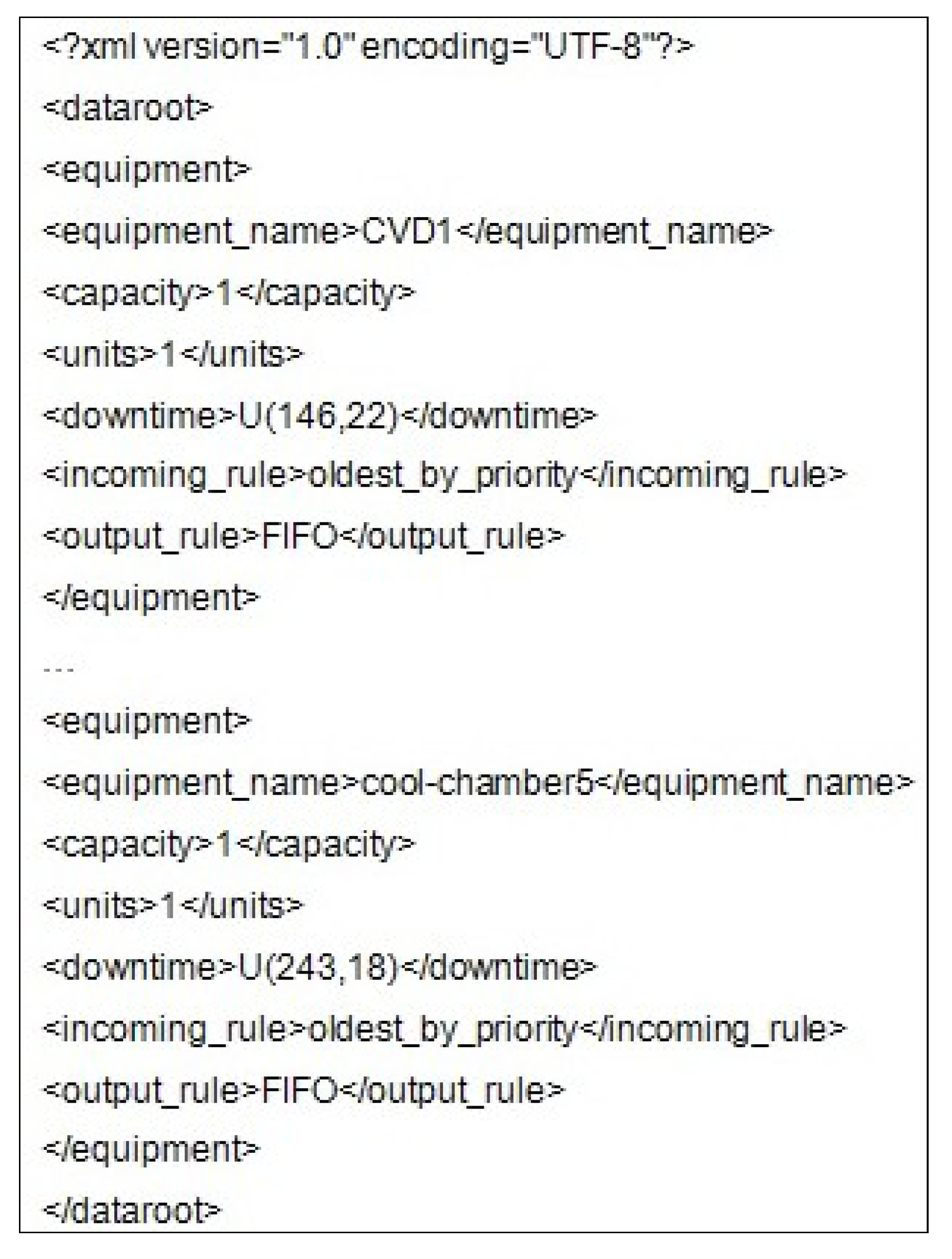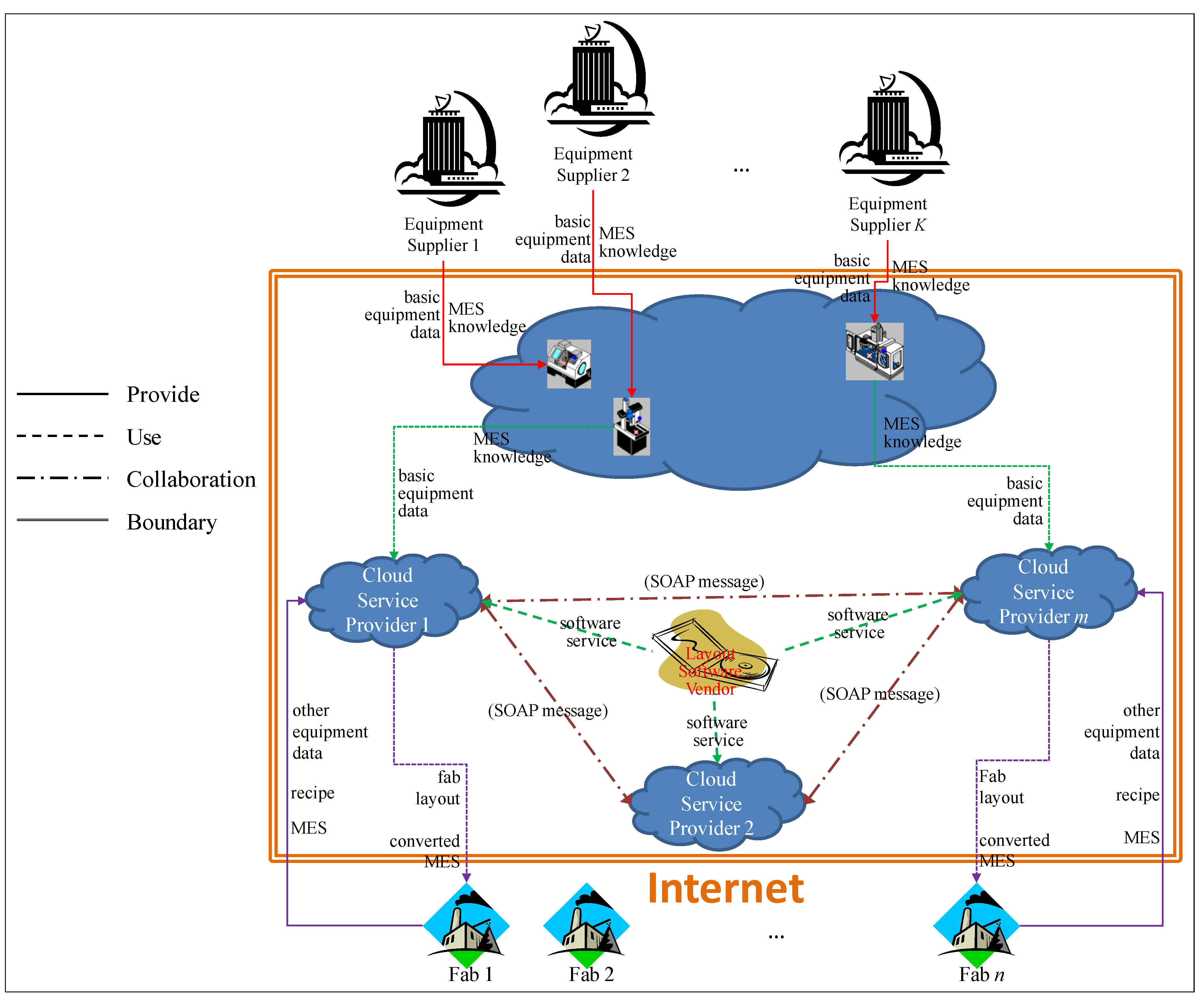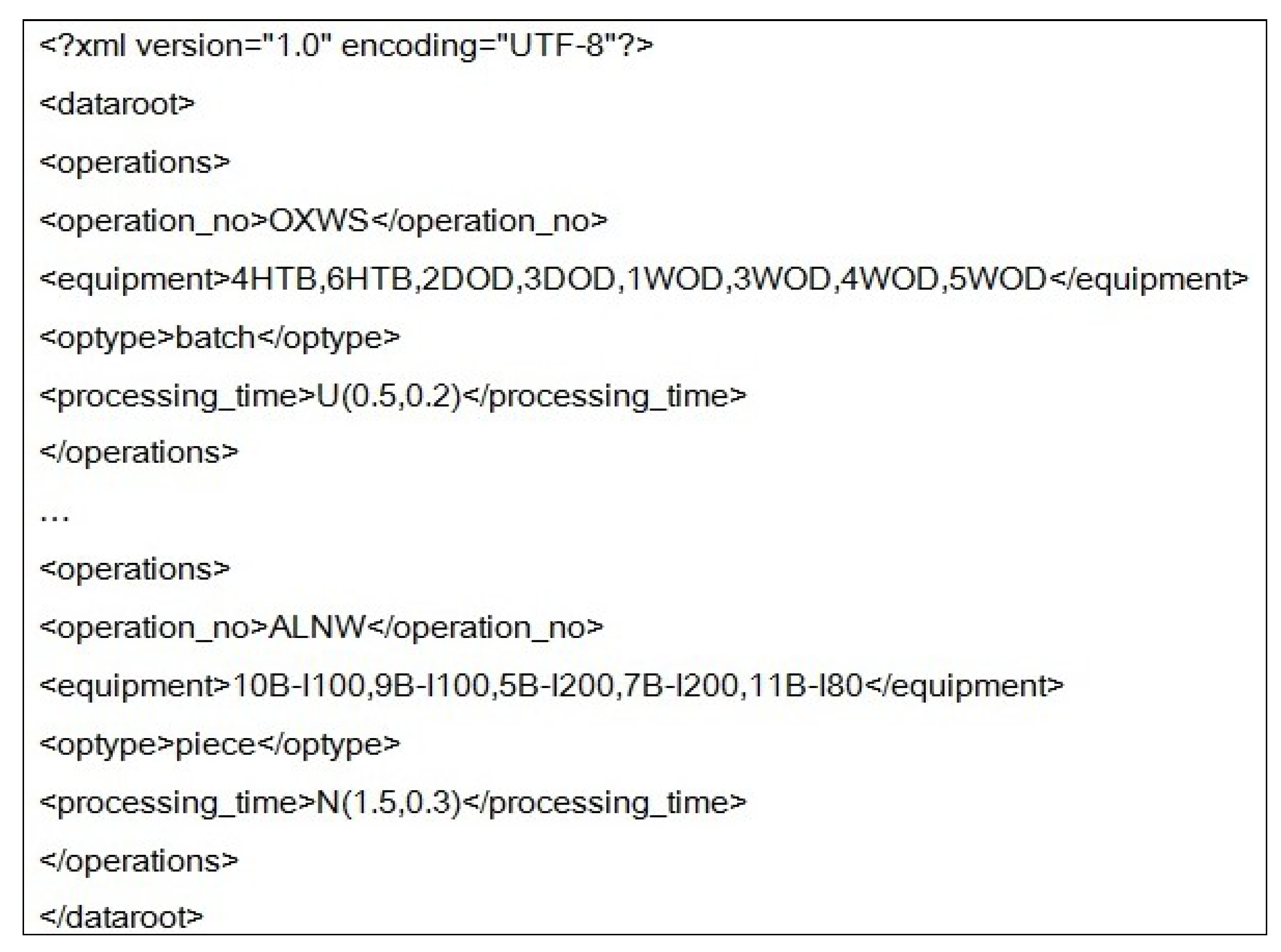Strengthening the Competitiveness and Sustainability of a Semiconductor Manufacturer with Cloud Manufacturing
Abstract
:1. Introduction
- (1)
- In December 2008, the Taiwan DRAM industry was on the verge of bankruptcy. The Ministry of Economic Affairs of Taiwan established the “DRAM Industry Task Force” to help Taiwan DRAM makers embark on organizational reengineering.
- (2)
- In January 2009, Germany DRAM maker Qimonda declared bankruptcy.
- (3)
- In February 2012, Japanese DRAM maker Elpida filed for bankruptcy protection.
- (1)
- Interaction: Manufacturing services usually rely on the interaction between users and services.
- (2)
- Real time: Manufacturing services must reflect the actual status of the equipment or design unit, and be able to respond to customer requests in a timely manner.
- (3)
- Cooperation: A variety of manufacturing services should be integrated to meet customer demand in a cooperative manner, i.e., manufacturing service composition.
- (4)
- Longer life cycle: Compared with information services, the life cycle of a manufacturing service may be longer.
- (5)
- Data-intensive: Compared to information services, manufacturing services often need to transfer or analyze a large amount of data.
- (6)
- Complicated functionality and infrastructure: The functionality of a manufacturing service, and the infrastructure for such a functionality, is often more complicated than expected, especially in a semiconductor manufacturing factory.
- (7)
- Highly specialized: The degree of specialization of manufacturing services is high; information technology is only a small part.
- (8)
- Expertise-based: Compared to information services that are usually based on data, manufacturing services are usually based on particular expertise.
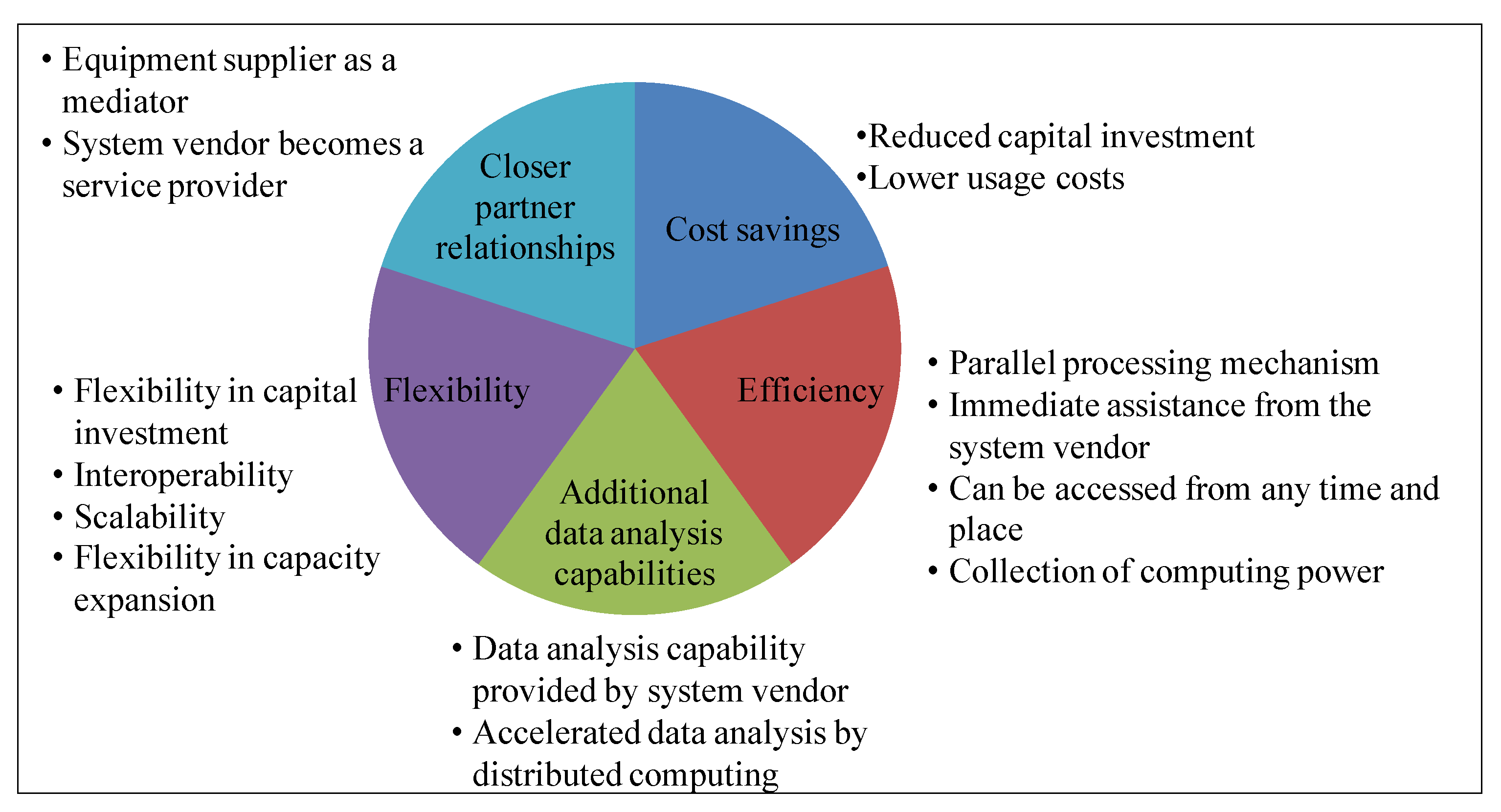
- (1)
- Manufacturing operations management people are conservative when it comes to change.
- (2)
- Internet connection is sometimes intermittent; that is not conducive to the continuous operations in manufacturing.
- (3)
- Decision makers are highly concerned about the safety of their manufacturing data on a public cloud.
2. Methodology
2.1. SWOT Analysis
- (1)
- The capital adequacy of a semiconductor manufacturer is very high.
- (2)
- The degree of automation of machinery and equipments in a semiconductor manufacturing factory is very high.
- (3)
- The system and information technology-related professionals are not lacking.
- (1)
- Since the capital adequacy of a semiconductor manufacturer is very high, it seems there is no need to rent an equipment or information system.
- (2)
- (3)
- Many production and operational data have a high degree of confidentiality, so they may not be suitable to be transmitted through the the Internet.
- (4)
- (1)
- The emergence of advanced manufacturing technologies, such as lean manufacturing (LM), cloud manufacturing (CMfg), manufacturing grid (MGrid), global manufacturing (GM), virtual manufacturing (VM), and agile manufacturing (AM). The definitions of these items are given in Table 1.
- (2)
- Cloud computing is widely applied.
- (3)
- Semiconductor manufacturers are seeking new ways to enhance their competitiveness and sustainability.
- (4)
- Most of the existing CMfg technologies are from the view of information technology, such as Xu [5] and Wu et al. [8], rather than from a manufacturing point of view. In other words, semiconductor manufacturers need manufacturing-oriented CMfg, supplemented by information technology. While information technology-oriented CMfg can be seen as the re-allocation of information technology resources of a manufacturer, such as ERP or CRM as a cloud service, manufacturing-oriented CMfg can be considered as “the re-allocation of manufacturing resources with the aid of cloud computing technologies”. For example, the scalability of a factory is the flexibility in expanding the capacity that is equivalent to the ease of re-allocating equipments from the suppliers to the factory. In addition, a bottleneck in a factory is a machine which capacity is allocated to many lots within the same time interval. To eliminate the bottleneck, other machines should be re-allocated to these lots instead somehow. To this end, factory simulation is a useful tool and can be enhanced with cloud computing technologies.
- (5)
- The popularity of smartphones increases the demand for semiconductors.
- (6)
- According to LNS Manufacturing Operations Management Survey, only 7% of respondents currently use cloud technology. However, 17% of respondents replied that they are planning to use cloud/SaaS (software as a service) based solutions for manufacturing operations management applications in the future [11].
- (1)
- The rise of the Chinese market, and of its manufacturers, brings opportunities and threats to existing firms.
- (2)
- There is a decline in the average selling price (ASP).
- (3)
- The advances in wafer fabrication processes turn into a cost advantage over the followers.
- (4)
- The huge investment in advanced fabrication processes will expand the advantage in cost, yield, production capacity, and other aspects in the future.
| Advanced Manufacturing Technology | Definition |
|---|---|
| Lean manufacturing (LM) | Lean manufacturing (LM) refers to a business concept wherein the goal is to minimize the amount of time and resources used in the manufacturing processes and other activities of an enterprise, with emphasis on eliminating all forms of wastage [18]. |
| Manufacturing grid (MGrid) | Manufacturing grid (MGrid) is a supportive environment to facilitate the sharing and integration of manufacturing resources by encapsulating and integrating design, manufacturing, management, information technology, and knowledge resources distributed in different regions or enterprises [7]. |
| Global manufacturing (GM) | All manufacturing operations are strategically located to provide total cost solutions for their customers [7]. |
| Virtual manufacturing (VM) | Virtual manufacturing (VM) is the use of computer models and simulation of manufacturing processes to aid in the design and production of products [19]. |
| Agile manufacturing (AM) | Agile manufacturing (AM) is to create the necessary processes, tools, and training to enable a manufacturer to respond quickly to customer needs and market changes while still controlling costs and quality [20]. |
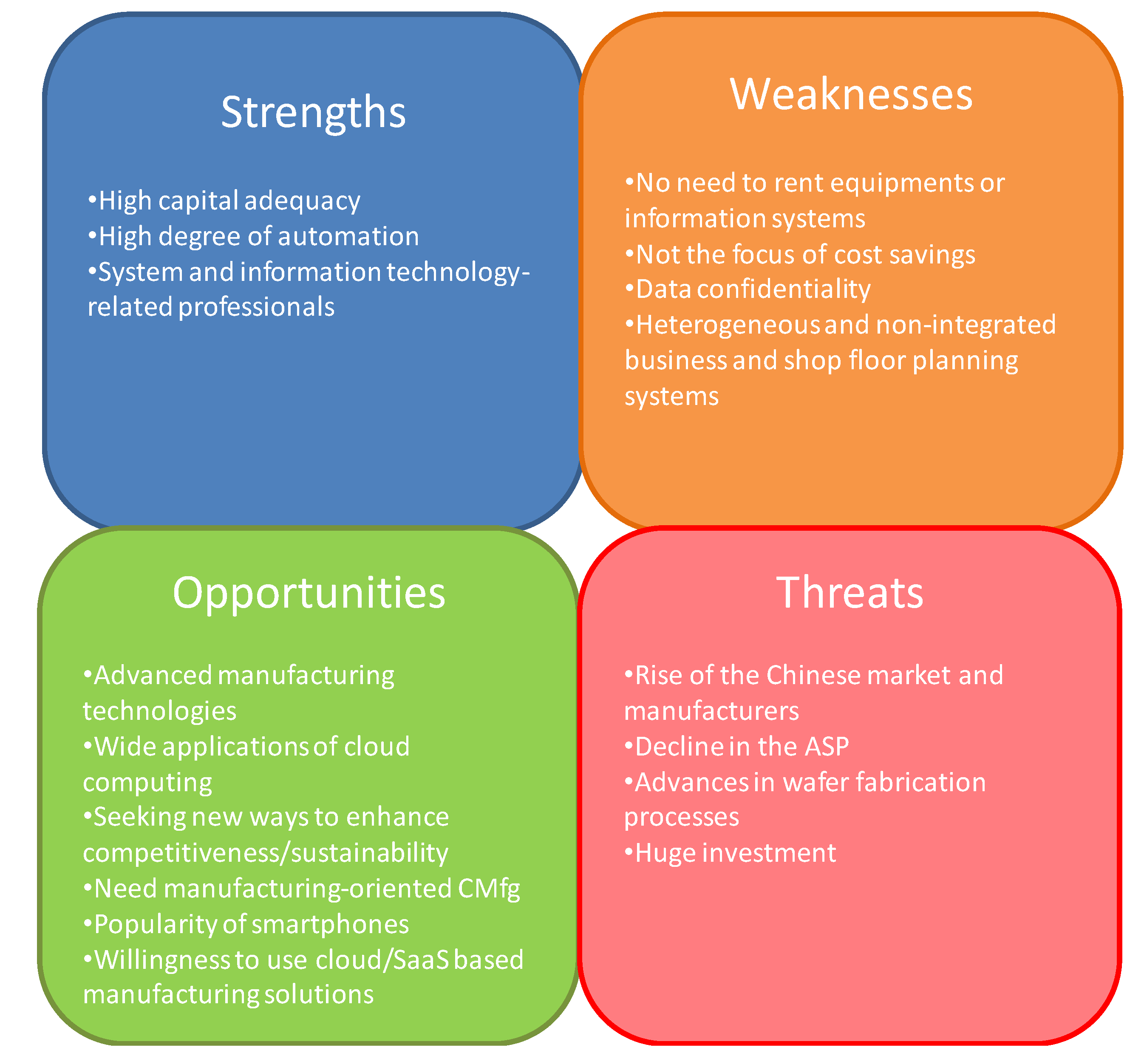
3. CMfg Applications for Fab Simulation

3.1. Fab Simulation as a Cloud Service (FSaaCS)
- (1)
- Preparing and analyzing data: Cloud service providers use their statistical analysis software to provide this functionality in response to a user’s request, i.e., the so-called statistical analysis as a cloud service (SAaaCS). Owing to the huge data, a user is suggested to upload an extensible markup language (XML) data file to be analyzed (see Figure 5) through a Web-based interface. The results are the corresponding probability distributions, regression equations, forecasts, or hypothesis testing results represented in a standard terminology across different cloud services and providers.
- (2)
- Defining equipments: Although visualization may not be so important for simulating a wafer fab, critical components to visualize a fab simulation model are the specifications, pictures, and other basic data of equipments that can be referenced from a pool maintained collaboratively by the equipment suppliers, i.e., the so-called equipment definition as a cloud service (EDaaCS), while some specifications of equipments may be customized and therefore are not publicly available data and should be uploaded in the form of an XML file (see Figure 6) by the wafer fab. The results of SAaaCS become an input to EDaaCS. Later on, a cloud service provider can build the layout on behalf of a wafer fab according to the equipment data with the assistance of a layout software vendor. The concept of EDaaCS is illustrated in Figure 7.Figure 4. The procedure for simulating a wafer fab.Figure 5. An example XML file for statistical analysis as a cloud service (SAaaCS).Figure 6. An example XML file for equipment definition as a cloud service (EDaaCS).Figure 7. The concept of EDaaCS.
- (3)
- Building the layout: Cloud services, such as Autodesk 360 Cloud Services, have been designed for facility layout, i.e., the so-called facility layout as cloud service (FLaaCS). Establishing the layout of a wafer fab is a laborious and time-consuming task. Fortunately, it is usually done once when a new wafer fab is being built. Later on, only maintenance (minor adjustment) will be needed. Since equipment specifications are an important factor to facility layout, the cloud service EDaaCS can contribute to the efficiency of laying out a wafer fab. In addition, if the capacity of a wafer fab is to be expanded, a major modification will need to be made to the fab layout. At this time, an easy-to-modify fab layout would be useful. That depends on specific computation intelligence, and should be supported by the software vendor as a FLaaCS. In other words, FLaaCS is important to the scalability of a wafer fab (see Figure 8).Figure 8. The relationships among EDaaCS, facility layout as cloud service (FLaaCS), and scalability.Figure 8. The relationships among EDaaCS, facility layout as cloud service (FLaaCS), and scalability.
- (4)
- Defining and converting recipes: In standalone fab simulation systems, the formats for recording recipes are usually different from system to system. In addition, some of these systems operate on the basis of sequential operations, while others are object-oriented. Further, some programs embedded into the operations may be coded in different languages. These difficulties have to be tackled in designing a cloud service for defining recipes, i.e., defining recipes as a cloud service (DRaaCS). An example XML file for defining a recipe is given in Figure 9. In addition, a cloud service provider can also help in defining the recipe of manufacturing a specific product, or in converting recipes or manufacturing execution systems (MES) with the aid of equipment suppliers, i.e., the so-called recipe conversion as a cloud service (RCaaCS), also shown in Figure 7. That is considered as an essential step to the interoperability of a wafer fab.Figure 9. An example XML file for defining recipes as a cloud service (DRaaCS).
- (5)
- Running simulation: In theory, CMfg helps run the simulation model of a wafer fab, i.e., running simulation as a cloud service (RSaaCS), in the following ways:
- (i)
- Replicating the same simulation on several clouds: Since multiple simulation runs are usually required to obtain the average and standard deviations of the relevant attributes, they can be simultaneously run on several clouds, and then be aggregated to arrive at the final results.
- (ii)
- Considering different possible values for uncertain/stochastic parameters: Many parameters in a fab simulation model are subject to uncertainties, so are usually represented using probability distributions. Different possible values of the same parameter can be taken into account at the same time by running the same simulation model on different clouds.
- (iii)
- Evaluating the performances of different scheduling methods: Usually the effectiveness of a scheduling method has to be evaluated with the simulation model before it can be applied to the actual production system. In the proposed methodology, several scheduling methods can be simultaneously evaluated on different clouds to facilitate the comparison of these scheduling methods.
- (iv)
- Partitioning the fab simulation model: As mentioned earlier, it usually takes a few hours to run a single replication of the fab simulation model. Such a problem can be tackled by dividing the fab simulation model into several smaller pieces that can be run on different clouds simultaneously and independently. Such a concept is illustrated in Figure 10. There are m machines in this system. Originally, the system must be simulated as a whole. In order to enhance the efficiency of simulation, the system is divided into two parts—subsystem 1 (including machines 1~p) and subsystem 2 (including machines p + 1~m). To this end, the arrival time of each job to machine p + 1 must be estimated, which then simulates the release time of the job to this machine. In this way, the two subsystems can be simulated at the same time. In a similar way, the system can be divided into Q subsystems indicated with q = 1~Q (see Figure 11). Subsystem q involves machines m(q − 1)/Q + 1~mq/Q. The arrival times of a job to these subsystems will be estimated when the job is released into the system. In the literature, there are a lot of methods for estimating the cycle time of a job, such as statistical analyses [21], soft computing applications [22,23], and hybrid approaches [24]. For a comprehensive literature review, refer to [25]. These methods can certainly be applied to estimate the step cycle time of a job. Then, the arrival time to a subsystem can be derived by adding the step cycle time of the previous subsystem to the release time.
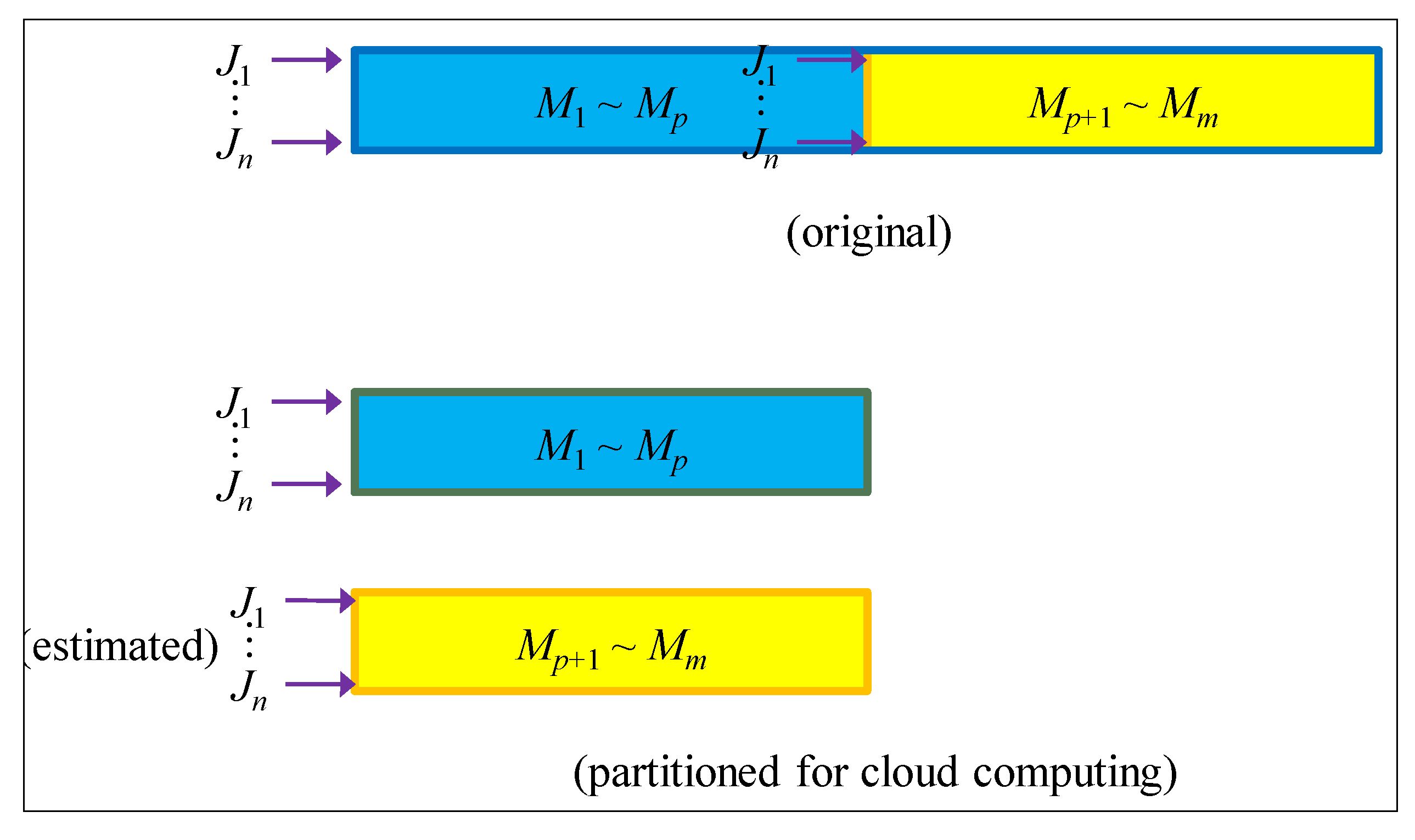
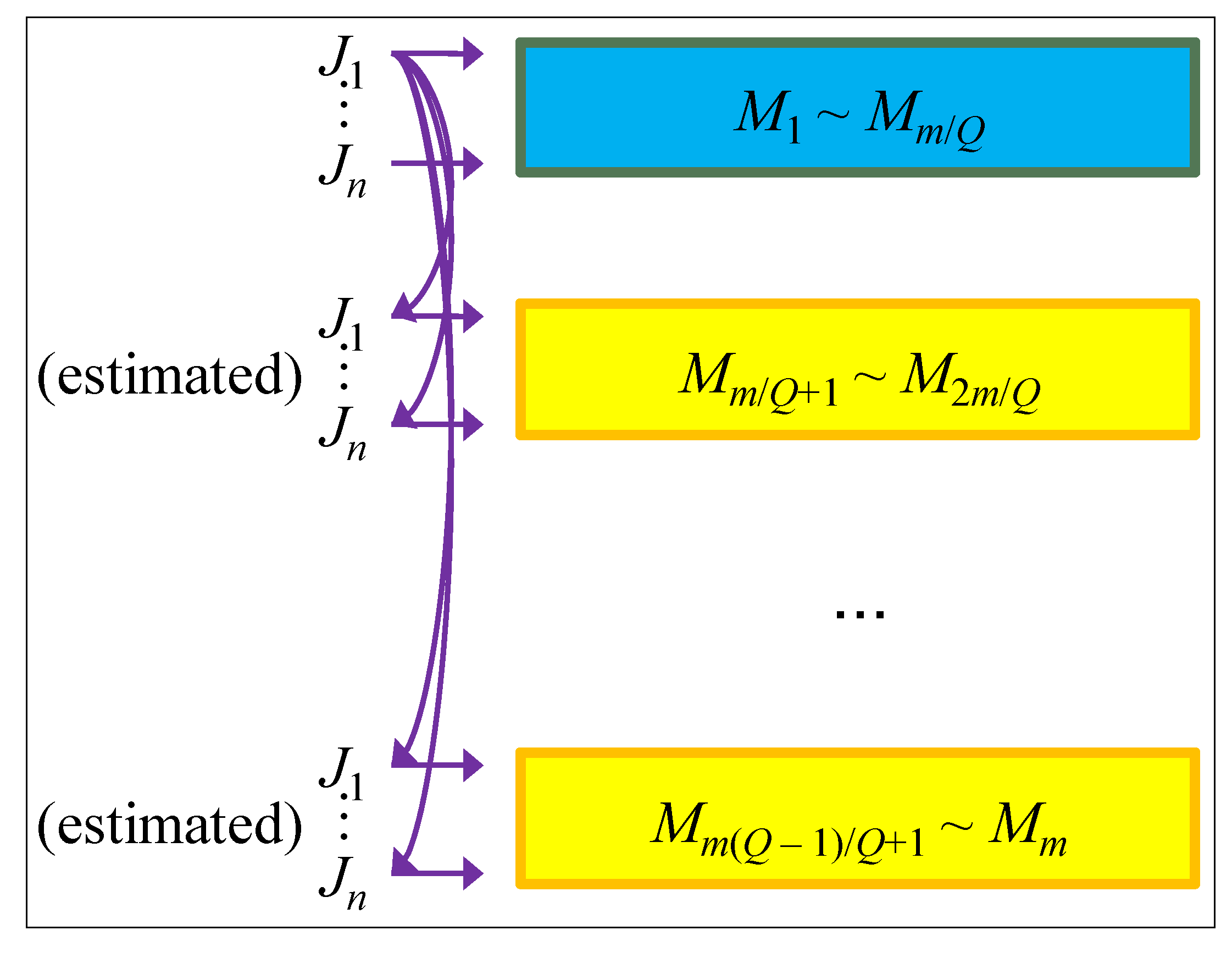
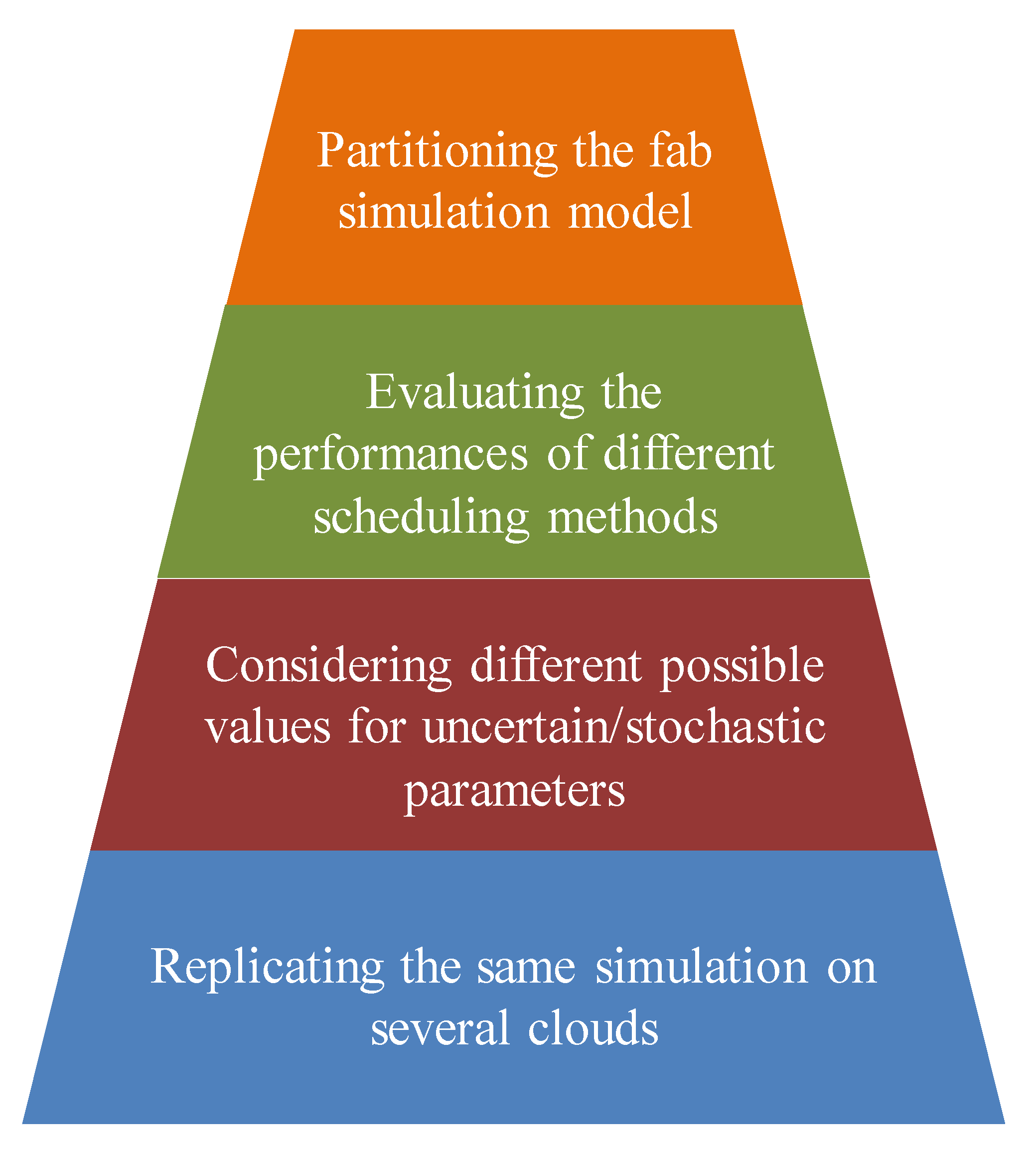
3.2. Connection with the Competitiveness and Sustainability
4. Conclusions and Future Research Directions
- (1)
- The applicability of CMfg to semiconductor manufacturing has rarely been discussed in the past. To this end, the results of the SWOT analysis performed in this study are worth considering.
- (2)
- Production simulation has always been a tough task for a wafer fab, which inhibits the ability of further decision-making analyses based on the simulation model. This study discussed the CMfg service of fab simulation, which, if successfully applied, can increase the likelihood of solving some critical problems in managing a wafer fab, such as the elimination of dynamic bottlenecks.
Acknowledgments
Conflicts of Interest
References
- ACEsuppliers. Available online: http://ssttpro.acesuppliers.com/semiconductor_news/hi_tech_enews_NewsId_6173.html (accessed on 11 November 2013).
- The Liberty Times. Available online: http://www.libertytimes.com.tw/2013/new/sep/5/today-e12.htm (accessed on 11 November 2013).
- Mell, P.; Grance, T. Perspectives on Cloud Computing and Standards; National Institute of Standards and Technology: Gaithersburg, MD, USA, 2009. [Google Scholar]
- Li, B.H.; Zhang, L.; Wang, S.L. Cloud manufacturing: A service-oriented new networked manufacturing model. Comput. Integr. Manuf. Syst. 2010, 16, 1–9. [Google Scholar]
- Xu, X. From cloud computing to cloud manufacturing. Robot. Comput. Integr. Manuf. 2012, 28, 75–86. [Google Scholar] [CrossRef]
- Zhang, L.; Guo, H.; Tao, F.; Luo, Y.L.; Si, N. Flexible Management of Resource Service Composition in Cloud Manufacturing. In Proceedings of the 2010 IEEE International Conference on Industrial Engineering and Engineering Management, Macao, China, 7–10 December 2010.
- Fan, Y.; Zhao, D.; Zhang, L.; Huang, S.; Liu, B. Manufacturing grid: Needs, concept and architecture. Lect. Notes Comput. Sci. 2004, 3032, 653–656. [Google Scholar]
- Wu, D.; Greer, M.J.; Rosen, D.W.; Schaefer, D. Cloud manufacturing: Strategic vision and state-of-the-art. J. Manuf. Syst. 2013, 32, 564–579. [Google Scholar] [CrossRef] [Green Version]
- Cloud Sherpas. Available online: http://www.cloudsherpas.com/cloud-services/manufacturing/ (accessed on 11 November 2013).
- Epicor. End-to-end on-Demand ERP Solution for Manufacturers. Available online: http://www.epicor.com/Cloud/Pages/Cloud-Manufacturing.aspx (accessed on 11 November 2013).
- Davidson, M. Why Cloud Manufacturing Software Adoption Rates Are Rising. Available online: https://www.manufacturing.net/articles/2013/10/why-cloud-manufacturing-software-adoption-rates-are-rising (accessed on 11 November 2013).
- Humphrey, A. SWOT Analysis for Management Consulting. Available online: http://www.sri.com/sites/default/files/brochures/dec-05.pdf (accessed on 11 November 2013).
- Chen, T. Enhancing the yield competitiveness of a semiconductor fabrication factory with dynamic capacity re-allocation. Comput. Ind. Eng. 2009, 57, 931–936. [Google Scholar] [CrossRef]
- Chen, T.; Wu, H.C.; Wang, Y.C. Fuzzy-neural approaches with example post-classification for estimating job cycle time in a wafer fab. Appl. Soft Comput. 2009, 9, 1225–1231. [Google Scholar] [CrossRef]
- Chen, T. A flexible way of modelling the long-term cost competitiveness of a semiconductor product. Robot. Comput. Integr. Manuf. 2013, 29, 31–40. [Google Scholar]
- Chen, T. A systematic cycle time reduction procedure for enhancing the competitiveness and sustainability of a semiconductor manufacturer. Sustainability 2013, 5, 4637–4652. [Google Scholar] [CrossRef]
- Makatsoris, C.; Leach, N.P.; Richards, H.D.; Besant, C.; Ristc, M. Addressing the Planning and Control Gaps in Semiconductor Virtual Enterprises. In IT and Manufacturing Partnerships; IOS Press: Amsterdam, The Netherlands, 1996. [Google Scholar]
- Lean Manufacturing. Available online: http://wenku.baidu.com/view/ac8334707fd5360cba1adb21.html (accessed on 11 November 2013).
- Lin, E.; Minis, I.; Nau, D.S.; Regli, W.C. Virtual Manufacturing. Available online: http://www.isr.umd.edu/Labs/CIM/virtual.html (accessed on 11 November 2013).
- Goldman, L.; Nagel, R.L.; Preiss, K. Agile Competitors and Virtual Organizations—Strategies for Enriching the Customer; Van Nostrand Reinhold: New York, NY, USA, 1995. [Google Scholar]
- Tirkel, I. Cycle Time Prediction in Wafer Fabrication Line by Applying Data Mining Methods. In Proceedings of the 22nd Annual IEEE/SEMI Advanced Semiconductor Manufacturing Conference, New York, NY, USA, 16–18 May 2011.
- Chen, T. A hybrid SOM-BPN approach to lot output time prediction in a wafer fab. Neural Process. Lett. 2006, 24, 271–288. [Google Scholar] [CrossRef]
- Chen, T. A FNP approach for evaluating and enhancing the long-term competitiveness of a semiconductor fabrication factory through yield learning modeling. Int. J. Adv. Manuf. Technol. 2009, 40, 993–1003. [Google Scholar] [CrossRef]
- Chen, T. An intelligent hybrid system for wafer lot output time prediction. Adv. Eng. Inform. 2007, 21, 55–65. [Google Scholar] [CrossRef]
- Chen, T. An effective fuzzy collaborative forecasting approach for predicting the job cycle time in wafer fabrication. Comput. Ind. Eng. 2013, 66, 834–848. [Google Scholar] [CrossRef]
- Miller, D.J. The Role of Simulation in Semiconductor Logistics. In Proceedings of the 1994 Winter Simulation Conference, Lake Buena Vista, FL, USA, 11–14 December 1994.
- Zott, C. Dynamic capabilities and the emergence of intraindustry differential firm performance: Insights from a simulation study. Strateg. Manag. J. 2003, 24, 97–125. [Google Scholar] [CrossRef]
© 2014 by the authors; licensee MDPI, Basel, Switzerland. This article is an open access article distributed under the terms and conditions of the Creative Commons Attribution license (http://creativecommons.org/licenses/by/3.0/).
Share and Cite
Chen, T. Strengthening the Competitiveness and Sustainability of a Semiconductor Manufacturer with Cloud Manufacturing. Sustainability 2014, 6, 251-266. https://doi.org/10.3390/su6010251
Chen T. Strengthening the Competitiveness and Sustainability of a Semiconductor Manufacturer with Cloud Manufacturing. Sustainability. 2014; 6(1):251-266. https://doi.org/10.3390/su6010251
Chicago/Turabian StyleChen, Toly. 2014. "Strengthening the Competitiveness and Sustainability of a Semiconductor Manufacturer with Cloud Manufacturing" Sustainability 6, no. 1: 251-266. https://doi.org/10.3390/su6010251




